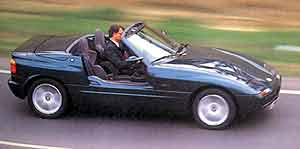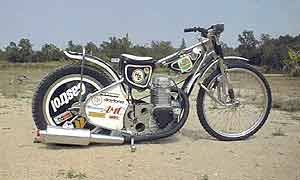Received an email from a mate in the UK who
had just seen a TV programme regarding restoration of
‘classic’ vehicles. This covered a ground up restoration of
an early E-type Jaguar. The finished article looked superb and
was highly acclaimed by many specialists in the programme, but
the cost! The owner said that it had cost 85,000 British pounds
which was 20,000 over his budget. It was, of course, a virtually
new car, so how much would a new E-type cost today? I guess not
far from the same amount, but who wants a new, 40 year old car?

Jaguar
XJS
That, of course, is the nub of it all. People
spend countless thousands of hours and dollars/pounds or
whatever restoring these classic cars, but when they are
finished, what have they really got - a very expensively
obtained museum piece. While the E-type in its day was
mind-blowing, compared to today’s Jaguars it is a dinosaur,
complete with dinosaur technology. That 6 cylinder Jaguar lump
was designed in the 40’s and first arrived in the XK 120 in
the early 50’s. That is no technological masterpiece to be
revered and worshipped - that’s a boat anchor!
The chemist next door to my surgery in Oz was
a concourse fanatic and owned the Jaguar XJS pictured here. The
car was 11 years old when he bought it, and it was in good
enough condition for you and me to take it to the local car wash
and sit back with a bottle of vino and then have photographs
taken of yourself standing beside it. But not for my chemist.
The Jag was taken to the body shop where it
spent the next 14 weeks, being totally disassembled, taken back
to bare metal and resprayed. On getting the car home, he then
took 24 photographs of the engine bay, so that everything could
go back in the right place, every little clip, ferrule and pipe.
 The next step was to hire a retired wrench
for 5 days to dismantle the ancillaries from the engine so that
he could clean the V12 block and heads. Only when that was done
did the engine bay get reassembled, with washers of differing
thicknesses being used so that when everything was torqued down,
the screw slots all pointed in the same direction! Certain areas
of the valley in the V12 had to be sluiced with degreaser to be
cleaned. To remove the fluid? You use a long straw and suck it
out! This, gentle reader, is auto fanaticism at its best!
The next step was to hire a retired wrench
for 5 days to dismantle the ancillaries from the engine so that
he could clean the V12 block and heads. Only when that was done
did the engine bay get reassembled, with washers of differing
thicknesses being used so that when everything was torqued down,
the screw slots all pointed in the same direction! Certain areas
of the valley in the V12 had to be sluiced with degreaser to be
cleaned. To remove the fluid? You use a long straw and suck it
out! This, gentle reader, is auto fanaticism at its best!
Many weeks were then spent under the car in
the classic Michelangelo position, cleaning the dirt of several
years from the underbody. I wonder if the Sistine chapel painter
had to clean the ceiling first before he painted it? My chemist
had to!
Everyone who has ever owned a British car or
motorcycle knows that oil leaks are the Standard British
Industry method of slowing down rust production, and as such are
a non-delete factory option. However, this is not the case for
the concourse vehicle which has points deducted for oil
incontinence. The gearbox in this XJS went back three times
before the auto shop could stop the weeping (both the gearbox
and the chemist)!
With a concourse vehicle, the standard of
preparation has to be faultless. If cleanliness is next to
godliness, then the true concourse car is in line to be the next
Pope.
Now what you also have to realise is that
these concourse cars have to be original in every respect as
well. The chap with the 427 Galaxy V8 installed in the E-type
need not bother entering. These cars have to be automotive
vestal virgins. Our chemist had one point deducted because he
had put on a very nice Momo steering wheel to replace the thin
and horrible Jaguar one. You may enhance, remanufacture,
refurbish and retouch - bit it must appear original.
The auto racer hears all sorts of noises as
the car gets driven to the grid. Anxiety becomes obvious. Will
the car make it to the chequered flag? For the concourse
entrant, this anxiety is mirrored on the way to the concourse
judging arena. Every taxi cab looks like a competitor from
“Days of Thunder” and every stone on the road looks ready to
cannon into the unchipped (brand new) windshield. With my
chemist and his Jaguar, he made it unscathed to the judging area
but as he opened his door to get out, the passenger in the car
next to him did the same thing. The resulting contact was to
lose him 2 1/2 points in the section called “Straightness of
Exterior Panels”.
However, he did win the Concourse, both for
XJS and overall best Jaguar that year with a score of 598 points
from a possible of 650. The effort had taken thousands of
dollars and 400 hours of the chemist’s time. Was it really
worth the time and money spent? The answer is probably the
meaning of life or the riddle of the universe, but my chemist
said it best when he penned the following four lines to finish
this article.
“Why do I concourse, instead of pit-crewing
it?
Why polish and paint and keep screwing and
gluing it?
And loving and hating and laughing and rueing
it?
If I knew why I did it, I’d probably stop doing it!”
The rumour mongers have it that when the new
season gets underway, Heinz-Harry Frentzen will be driving for
Orange Arrows this year. Apparently, somebody has also been
going through his bank books and says that H-HF was on 6 million
pounds last year at Jordan, but at Arrows he will be scarcely
making ends meet, getting only 450,000 British pounds per year,
or otherwise expressed as 1,232 British pounds a day (that’s
about 28 million baht annually, or in monthly salary terms, 2.3
million baht, or a trifling 76,000 baht a day in the bank).
Now while I have been crazily passionate
about motor racing most of my life, almost half a million quid
is still far too much of an annual salary. Motor racing is a
personal selfish passion - driving F1 cars does nothing to help
the oppressed, the needy or elevate the standards in the world,
so why the big money? Schumi, the best driver around by far,
makes over 50 million dollars a year. This is obscene! I’m
sorry, you cannot justify this in any way. The best brain
surgeon in the world gets nowhere that sort of money, despite
around a dozen years training and the making of life or death
decisions for other people. So the race driver “risks” his
own life. So? It is his choice and not one that should be
rewarded in his bank account.
That reminds me of the tale about the brain surgeon whose
toilet blocked one day. He rang the emergency plumber who came
over and fixed it in 10 minutes. “That’ll be $500,” said
the plumber. “Goodness me,” said the brain surgeon, “Not
even I as a brain surgeon makes that kind of money.”
“Neither could I, when I was one,” replied the plumber!


 The next step was to hire a retired wrench
for 5 days to dismantle the ancillaries from the engine so that
he could clean the V12 block and heads. Only when that was done
did the engine bay get reassembled, with washers of differing
thicknesses being used so that when everything was torqued down,
the screw slots all pointed in the same direction! Certain areas
of the valley in the V12 had to be sluiced with degreaser to be
cleaned. To remove the fluid? You use a long straw and suck it
out! This, gentle reader, is auto fanaticism at its best!
The next step was to hire a retired wrench
for 5 days to dismantle the ancillaries from the engine so that
he could clean the V12 block and heads. Only when that was done
did the engine bay get reassembled, with washers of differing
thicknesses being used so that when everything was torqued down,
the screw slots all pointed in the same direction! Certain areas
of the valley in the V12 had to be sluiced with degreaser to be
cleaned. To remove the fluid? You use a long straw and suck it
out! This, gentle reader, is auto fanaticism at its best! Last week I asked you to have a look at
this photo. I asked what was this car? The clues were that
they built 8,093 of them, the doors were electrically
actuated and dropped down into the high sills and it was
very expensive.
Last week I asked you to have a look at
this photo. I asked what was this car? The clues were that
they built 8,093 of them, the doors were electrically
actuated and dropped down into the high sills and it was
very expensive. And so to this week. This picture shows
a Porsche Boxster, so that isn’t the question! What I
want to know is where did the name “Boxster” come
from? This one is very easy.
And so to this week. This picture shows
a Porsche Boxster, so that isn’t the question! What I
want to know is where did the name “Boxster” come
from? This one is very easy. Ferrari, who it is rumoured pay Schumacher at
least $25 million a year (compare that to poor old Heinz-Harry,
starving on roundabout one mill), have also taken out a policy
covering their commitments to their number 1 driver. Schumacher
continues to be one of the highest-paid sportsmen and
entertainers in the world, and is the top yet again in Europe.
Ferrari, who it is rumoured pay Schumacher at
least $25 million a year (compare that to poor old Heinz-Harry,
starving on roundabout one mill), have also taken out a policy
covering their commitments to their number 1 driver. Schumacher
continues to be one of the highest-paid sportsmen and
entertainers in the world, and is the top yet again in Europe.